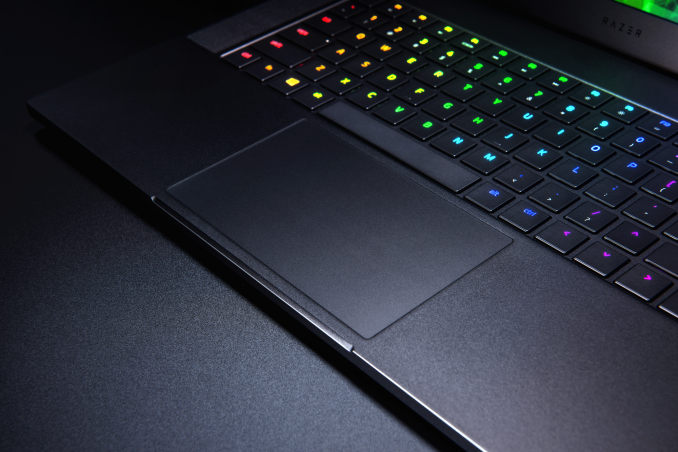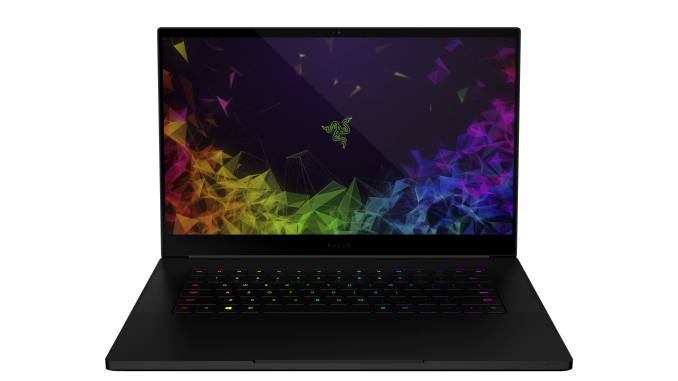Razer Launches The Razer Blade 15.6
by Brett Howse on May 22, 2018 3:01 AM EST- Posted in
- Laptops
- Razer
- Razer Blade
- eGFX
- Max-Q

Today Razer is taking the wraps off a new model in their lineup. The Razer Blade 15.6 slots in as a replacement for the 14, and boasts some features we’ve not seen in the rest of their lineup yet. They’ll be offering it in a variety of configurations, with different displays, and either a NVIDIA GTX 1060 Max-Q, or GTX 1070 Max-Q GPU.
Razer has done a fantastic job of taking their best-in-class CNC aluminum chassis and evolving it to keep it fresh. With the 15.6, it’s what you’d expect in a Razer Blade: thin and light. It also boasts some very narrow bezels, at just 4.9 mm, but with the top bezel slightly larger to accommodate the webcam in the correct location. Razer has moved to a clickable touchpad, letting them add a slightly larger one as well, and it ships with Precision drivers. And to fit in with the rest of the thin lineup, the GTX 1060 model is just 16.8 mm thick, while the GTX 1070 is only a half millimeter thicker. Weight is 2.07 – 2.15 kg (4.56 – 4.73 lbs) depending on the specs.
Let’s talk about specs. The Razer Blade 15.6 is shipping with the Intel Core i7-8750H CPU as the only processor option. This offers six cores, twelve threads, and up to 4.1 GHz of turbo. It’s shipping with 16 GB of DDR4, although the system will be offered with32 GB as well. The base SSD is a 512 GB PCIe model, with up to 2 TB available. GPU options, as mentioned, are either GTX 1060 or 1070 Max-Q models, which should offer good performance but thermals that this thin laptop can support.
| Razer Blade 15.6 | |||||
| Models | GTX 1060 | GTX 1070 | |||
| CPU | Intel Core i7-8750H 6 Cores, 12 Threads 2.2 GHz - 4.1 GHz, 45W TDP |
||||
| RAM | 16 GB - 32 GB DDR4-2667 | ||||
| GPU | NVIDIA GTX 1060 Max-Q 1280 CUDA Cores 6 GB GDDR5 192-bit |
NVIDIA GTX 1070 Max-Q 2048 CUDA Cores 8 GB GDDR5 256-bit |
|||
| Storage | 512 GB - 2 TB PCIe NVMe SSDs | ||||
| Display | 1920x1080 60Hz IPS matte 1920x1080 144Hz IPS matte (optional) 3840x2160 60Hz IPS with touch factory calibrated displays |
||||
| Wireless | Intel Wireless-AC 9260 802.11ac 160MHz channel support MU-MIMO 2x2:2 Bluetooth 5 |
||||
| Connectivity | Thunderbolt 3 USB-C x 1 USB 3.0 x 3 mDP 1.4 x 1 HDMI 2.0b x 1 |
||||
| Battery | 80 Wh 200 W Adapter |
80 Wh 230 W Adapter |
|||
| Dimensions | 355 x 325 x 16.8 mm 14 x 9.3 x 0.66 inches |
355 x 235 x 17.3 mm 14 x 9.3 x 0.68 inches |
|||
| Weight | 2.07 kg / 4.56 lbs (non-touch) 2.15 kg / 4.73 lbs (touch UHD) |
||||
| Price | $1899.99 and up | $2399.99 and up | |||
There’s plenty of connectivity as well, and starting with wireless, Razer has gone back to an Intel Wireless solution with the latest generation Intel Wireless-AC 9260. Razer had been using Killer Wireless for the last couple of generations, but interestingly they’ve moved back to an Intel one when Killer is also using this same NIC as the platform for their 1550. But regardless, the 9260 is a solid looking update over the 8260, with the same 2x2:2 configuration, but adding support for 160 MHz channels as well, so the max connection rate is now 1.73 Gbps if your router has 160 Mhz available. Razer is of course also offering Thunderbolt 3 on a USB-C port, which is required for their eGFX enclosures, including the just launched Razer Core X. In addition, there’s three USB 3 ports, mini DisplayPort 1.4, and HDMI 2.0b.
Razer is offering three display choices as well, to hit a wider range of client needs. The base model is a 60 Hz 1920x1080 display, but for those that want nothing but smoothness, you can also move to a 144 Hz 1920x1080 panel with 100% sRGB coverage. For those that want clarity at the expense of refresh rate, there’s also a 3840x2160 panel offered with a 60 Hz refresh, and 100% Adobe RGB support. And, Razer is now individually calibrating each panel at the factory which should improve panel performance tremendously. That’s fantastic to see, since Razer tends to be on the premium end of the price range.
Battery life should be decent as well, since the laptop ships with an 80 Wh capacity, and it includes NVIDIA Optimus support to bypass the GPU when its not needed. For charging, it ships with either a 200-Watt, or 230-Watt adapter, depending on the GPU.
And in case you aren’t up on the standard features on the Razer laptop lineup, the new 15.6-inch model also comes with per-key RGB lighting, which can be controlled with Razer’s Chroma software, and the keyboard is also anti-ghosting. The stereo speakers flank the keyboard, offering forward facing audio as well.
Razer is yet again offering one of the nicest looking gaming laptops around, and it’s packed with the latest tech too. It’s great to see them move to calibrated displays, highlighting the premium nature of their lineup. Their lineup now offers a wide variety of models, which should let them attract more of the market than before. We’re hoping to get a review unit for this new model soon, so stay tuned.
Source: Razer













20 Comments
View All Comments
wintermute000 - Wednesday, May 23, 2018 - link
Exactly, the lack of decent support and dell like NBD onsite pro support means this is a no go. I'm not paying 3k+ for a daily driver that I have to mail overseas for serviceGunbuster - Tuesday, May 22, 2018 - link
Razer who will ban you from their social media accounts on a whim if they interpret anything you say and not 100% ra-ra suckup posting... give them $2400? Nope.boeush - Tuesday, May 22, 2018 - link
Not a knock on Razer specifically, but it's a shame that there is no middle-ground option for laptop displays. Either it's 1080p, or it's full 4K. Wouldn't it be nice to also have the option of 3K (i.e. 2560x1440) - as a compromise that significantly increases sharpness relative to full-HD while having a much less severe impact on framerates/battery?nimi - Wednesday, May 23, 2018 - link
Such panels are uncommon, thus much higher priced. It'll probably end up costing the same as or more than the 4K model, killing itself in the process. So I think not having the option is the reasonable outcome.boeush - Wednesday, May 23, 2018 - link
Chicken. vs. egg: if the panels are not even an option, then they will indeed remain 'uncommon'. Strangely, such 3K) resolutions are much more easily available in 27" desktop monitor form factor - where they are indeed quite effective and popular, as far as I can tell. So the conundrum is, why are they good enough at 27", but not good enough at 15.6"?moozooh - Thursday, May 24, 2018 - link
This might be a long shot, but I think the high-density laptop screens mostly reuse the technological processes and solutions originally developed for smartphone screens, so there are a lot less expenses involved in adapting those to larger panels.Another idea is that 1080 is a very strong compatibility standard every application, media content, and other things created in the last 10–12 years or so are either released in or tested against. Naturally, it more often than not works best at that resolution. On 15.6–18" laptops a 1080p screen provides the extra benefit of not (always) having to use OS-level scaling which is almost always horrible. So those that deem it enough will not upgrade to 1440p as it won't really help much in terms of screen estate (screens themselves don't grow with resolution after all) yet might introduce more problems than it will solve.
Those that will upgrade to higher pixel density, however, might just want to double-down on it to solve problems associated with its increase and non-1:1 graphics scaling. Because the interpolation that might be visible at ~190 PPI might not bother one as much at ~280. So you can drop the resolution by an exact factor of 4 to 1080p and enjoy the 1080p content looking almost as good as on the actual 1080p screen.
Sarchasm - Tuesday, May 22, 2018 - link
Lots of problems here. 144hz, but no G-Sync (EVGA's SC series has it). Max-Q takes a hit on performance, so you're paying extra for thinness... ironic given all the shade Razer has thrown at Apple for doing the same. And don't even get me started on the wonkiness of the keyboard layout, which is going to feel cramped and awkward because they insisted on accommodating full-size arrow keys. The lack of screen bezels is a needed improvement from the old generation, but there are simply way too many design compromises to warrant $2k+ for the sticker.hfm - Tuesday, May 22, 2018 - link
G-Sync is only truly useful at lower frame rates, I don't think a 1070 is ill pared with a 144Hz panel that it's going to blast past that refresh and start to cause tearing.MamiyaOtaru - Tuesday, May 22, 2018 - link
what? It's arguably even more important on a high refresh rate screen. Your game is even less likely to hit the refresh rate and be able to safely vsync. And without vsync (or gsync) it'll tear at framerates above 60 just as well as below. Tearing doesn't just happen when a game "blast(s) past (the) refresh"highfly117 - Thursday, May 24, 2018 - link
it's for battery life both Optimus and G-sync are incompatible so it's one or the other. Without Optimus you could cut the battery life by half.